A Farewell to Truth
ANGLO AMERICA, 19 Aug 2024
Scott Ritter | Consortium News – TRANSCEND Media Service
The F.B.I. agents did more than seize my personal electronics when they searched my home on Aug. 7, the author writes. They stole the truth.
16 Aug 2024 – The execution of a search warrant on my residence by the F.B.I. on Aug. 7 was not my first run-in with America’s premier law enforcement agency.
In the 1990s, when I was working as chief weapons inspector for the United Nations Special Commission (UNSCOM) — set up by the U.N. Security Council to disarm Iraq as part of the ceasefire that ended the 1991 Gulf War — the F.B.I.’s National Security Division undertook an investigation premised on the working theory that I was committing espionage on behalf of the State of Israel.
The keystone fact that held their case together was that I had, on multiple occasions, travelled to Israel for the purpose of turning over rolls of U-2 film for joint imagery interpretation work conducted by Israel photo interpreters and those of UNSCOM (including myself.)
The U.S. refused to give UNSCOM its own photo-interpretation capability, and would not allow UNSCOM into their photo-interpretation center to evaluate the U-2 imagery.
Israel had a significant amount of intelligence they wanted to share. Much of it couldn’t be shared without revealing sources and methods. The joint exploitation of imagery allowed the Israelis to release intelligence by claiming it was revealed through the evaluation of imagery, or that the imagery opened the door to share additional information.
It was one of the most fruitful intelligence collaborations I was involved in, and the C.I.A. hated it because it took the control of out of their hands of what, and where, UNSCOM inspected.
The U-2 film was the byproduct of what was known as “Olive Branch,” a program set up between the United States and UNSCOM in which a U-2 high-altitude surveillance aircraft, flown by a U.S. military pilot who had been designated as a U.N. “expert on mission.”
The U-2’s classic black color scheme was an integral part of the integral heat and protective shield of the aircraft, and as such the airframe could not be painted in the traditional all-white color of United Nations aircraft on official missions. However, the aircraft was marked with a white “U.N.” on its tail.
The U-2 aircraft would only fly over Iraq with the permission of UNSCOM and would only image those areas inside Iraq designated by UNSCOM as being of interest.
Under the terms of the official protocol agreed to by the U.S. and UNSCOM, the U.S. would provide UNSCOM with high quality prints, but not negatives, of the targets designated for collection by UNSCOM. These prints would be stored by UNSCOM using its own security arrangements.
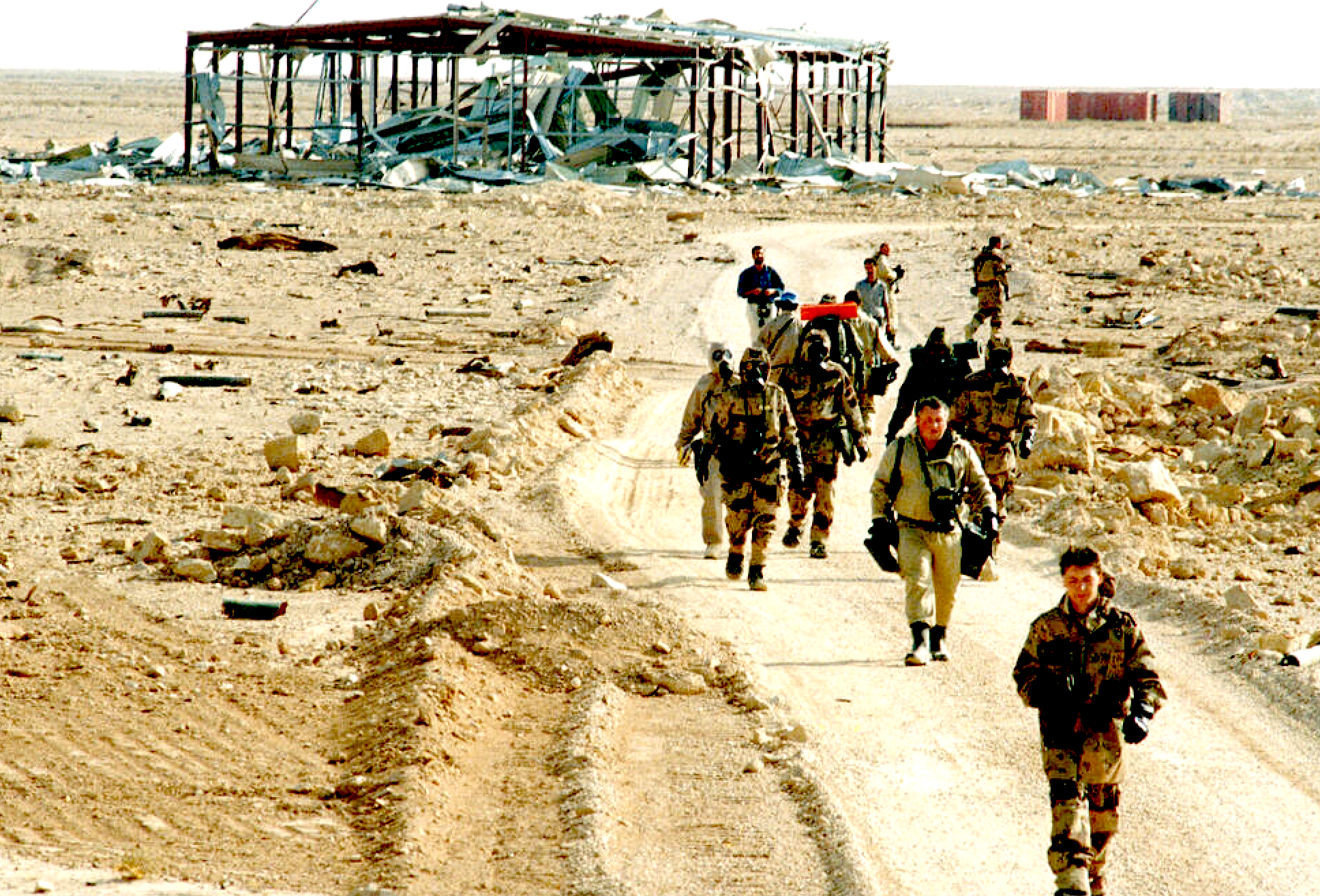
UNSCOM inspection team, in Iraq as part of a U.N. ceasefire agreement requiring the elimination of Iraq’s weapons of mass destruction, return from a destroyed warehouse at Muhammadiyat Storage site, Oct. 22, 1991. (UN Photo/H. Arvidsson)
In 1995 I participated in a meeting between UNSCOM and the C.I.A. where it was agreed that the C.I.A. would provide me with rolls of developed U-2 film which I would then transport to Israel for the express purpose of conducting joint imagery analysis with Israeli photo interpreters.
During the initial mission, the Israelis wanted to make prints of the targets of interest that had been revealed by our joint work. To do this, however, the Israelis had to convert the roll of film into a negative.
The protocol governing my work in Israel allowed me, as the expert on mission, to institute imagery handling procedures above and beyond those listed in the original protocol in consultation with the supporting government (i.e., Israel). As such, the Israelis and I agreed that they would make a negative copy of the film roll and use this to make prints of sites of interest to UNSCOM.
The C.I.A. claimed Israel could use the U-2 imagery for planning purposes regarding air attacks on Iraq. But by the time the imagery got to Israel, it was already more than a month old. Plus, as Israel showed me, they had their own high resolution satellites which provided real-time coverage of sensitive targets in Iraq. Being able to print out a U-2 image meant Israel didn’t have to share top-secret satellite imagery.
Upon my departure from Israel, I was to bring with me the original roll of film, the negative copy and copies of any prints that had been made by the Israelis. I authorized the Israelis to keep a copy of the prints for their own records, in case there was a need to further consult on the images.
Upon my return to the United States, I travelled to Washington, D.C., where I arranged a meeting with the State Department’s Special Commission Support Office (SCSO). There I tried to return not only the original roll of film, but also the negative copy.
I was told by the SCSO that they could receive the original roll of film, but that they were not permitted to take into custody the negative copy. I returned to UNSCOM with the negative copies.
Storage Problem
One of the problems I faced at the time was that my relationship with Israel was limited to only a few people inside UNSCOM. UNSCOM maintained a safe where we stored the high-quality U-2 prints provided by UNSCOM.
However, the number of people who had access to this safe, including UNSCOM personnel from several different countries (including Russia) was significant, making my ability to store the negative copy roll in that safe impossible, since its presence would potentially compromise the Israeli cooperation. The same held true concerning the U-2 prints produced by Israel.
The solution was simple — I took the negative roll and Israeli prints home, where I stored them in a filing cabinet located in my basement.
I was originally brought to UNSCOM for the purpose of helping set up a U.N. intelligence unit capable of receiving and assessing intelligence information provided by supporting nations in support of our inspection work. Many nations provided such intelligence.
The problem was UNSCOM needed to retain copies of this intelligence so that it could be properly assessed over the long term. The documents provided would either contain no classification markings or, if they did, would be appended with “release to UNSCOM.”
For the most part, these documents would be stored in the common UNSCOM safe. However, as the Iraqi efforts to conceal proscribed materials and activities intensified, and as the extent to which Iraq and its supporters among sympathetic nations (France comes to mind) infiltrated UNSCOM, intelligence information pertaining to missions that were planned as “no notice” surprise inspections had to be compartmentalized.
I had tried to get the U.S. government to set up a safe house outside the U.N. Headquarters building where these materials could be stored and accessed by designated UNSCOM personnel, but the C.I.A. balked at the expense.
As such, to prevent the contents of the sensitive planning documents pertaining to these no-notice inspections, I would take these documents home with me and store them in the file cabinet in my basement.
FBI Investigation
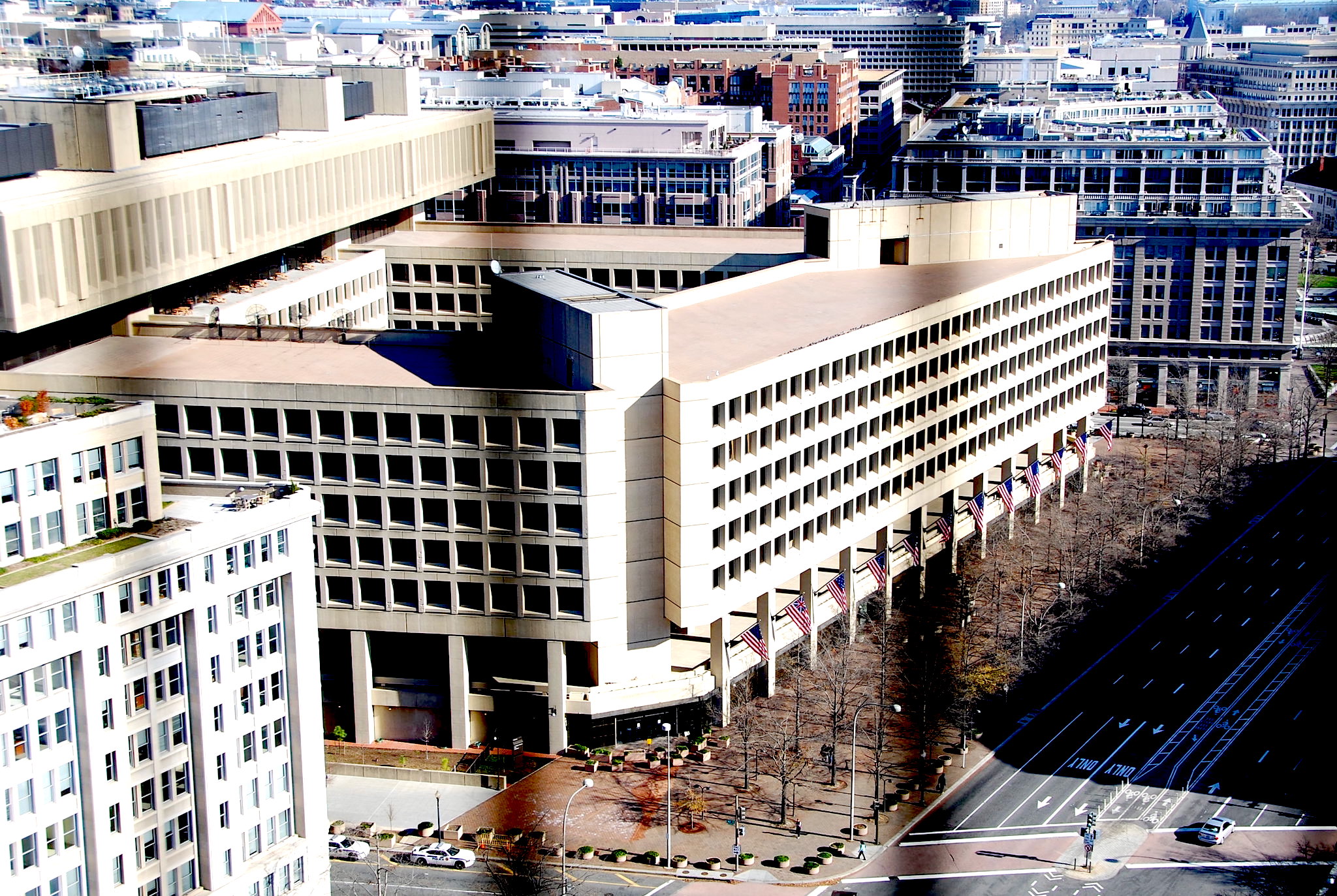
Aerial view of FBI headquarters in Washington, D.C., 2011. (Adam Fagen, Flickr, CC BY-NC-SA 2.0)
In 1997 the F.B.I. was informed that I was taking U-2 imagery to Israel. This imagery was marked “Secret Release UNSCOM,” but from the F.B.I.’s perspective, all they focused on was “Secret.”
They began an investigation.
At the time that the investigation began, I had implemented a covert communications intercept program inside Iraq which I oversaw in close coordination with the C.I.A. (which provided the equipment), the British GCHQ (which provided the personnel), and the Israeli Unit 8200, which provided the code-breaking and transcription.
Many of the reports generated by the Israelis were marked either “Secret” or “Top Secret.”
The nature of this operation was such that it was known to only a very small select number of UNSCOM personnel, which meant — you guessed it — documents produced in support this project and derived from this project were stored in the file cabinet in my basement.
The nature of this work required me to be in close contact with both the British MI-6 representative in New York, and designated Israeli personnel working out of the Israeli Mission to the United Nations.
There were many days when I would literally shuttle between the Israeli and U.K. Missions, coordinating on urgent operational matters, and often stopping off at the U.S. Mission to coordinate with the C.I.A. liaison there.
In June 1998, during a particularly hectic time, I was making my way from the U.K. Mission to the U.S. Mission when I was met by the C.I.A. liaison in the streets of New York City.
“I don’t want to meet you inside the Mission,” the C.I.A. liaison said. “The F.B.I. has a hard on for you and are getting ready to bring you in for questioning. They may grab you off the street tonight on your way home.”
This was, of course, disconcerting.
“For what?” I asked.
“Spying for Israel. The F.B.I. thinks you’re handing over classified information to the Israelis.”
“Like what?”
“The U-2 film.”
“But you give it to me so I can take it to Israel. This makes no sense.”
The liaison agreed. “It is what it is. Where are you heading now?”
“The Israeli Mission.”
The C.I.A. liaison scanned the building surrounding our meeting place. “Great. Now the F.B.I. has me on film talking to you. Good luck!”
Later, in August, when I was preparing to resign from UNSCOM in protest over U.S. interference, the C.I.A. liaison officer invited me up to his working space, where he showed me a classified letter from the C.I.A.’s general counsel addressed to the F.B.I.
The gist of the letter was that since UNSCOM was an international organization staffed primarily by foreign nationals, the U.S. was prohibited from providing classified information to it. As such, by law, all documents and materials which were turned over by the U.S. government to UNSCOM became automatically declassified at the time they were received by UNSCOM.
“That solves that,” the C.I.A. liaison said. “If the F.B.I. gives you any trouble, just reference this letter.”
“Can I have a copy?” I asked.
“It’s classified Secret,” he said. “I can’t give it to you for retention.”
Go figure.
The F.B.I. didn’t sweep me off the street, but thanks to CBS News, I became aware that the F.B.I. continued to investigate me for espionage even after I resigned from UNSCOM. The investigation was being run by David N. Kelley, the chief of the Organized Crime and Terrorism Division of the Southern District of New York. Mary Jo White, the U.S. attorney for the Southern District, was overseeing the overall investigation.
The investigation continued for more than two years. Finally, after I agreed to be interviewed under what is known as “Queen for the Day” agreement, three F.B.I. agents conducted the interview, after which the Southern District informed me the matter had been dropped.
The Receipts
But I still retained the archive. When, in the summer of 1998, it became clear that the U.S. was undermining the work of UNSCOM, I began copying critical files, which would be used to document this interference.
Most of these documents dealt with inspections and the planning that went into them, including the briefings that I had prepared for the UNSCOM executive chairman’s signature that outlined the goals and objectives of each mission.
I used these documents as sources for the various articles and books I wrote documenting the behavior of the U.S. government regarding Iraq and UNSCOM inspections. In the vernacular of today, these documents would be referred to as “receipts.”
I had the “receipts” which documented the lies of the U.S. when it came to their narrative that Iraq retained proscribed weapons of mass destruction.
I provided copies of many of these documents to Barton Gellman, The Washington Post reporter who wrote a detailed series of articles spelling out my claim that the U.S. was using UNSCOM to spy on Iraq. Initially the U.S. government took the position that I was lying.
When Gellman informed them that he had the receipts, the U.S. government changed its tune, simply saying that I “lacked the context” to fully understand U.S. policy behind the actions I had documented.
Which was rich, since I had been with the U.S. government, side-by-side, implementing these policies, almost all of which were conceived by me and adopted after I briefed senior U.S. leadership of the need to implement them.
I had the receipts.
Article Distributed to Congress
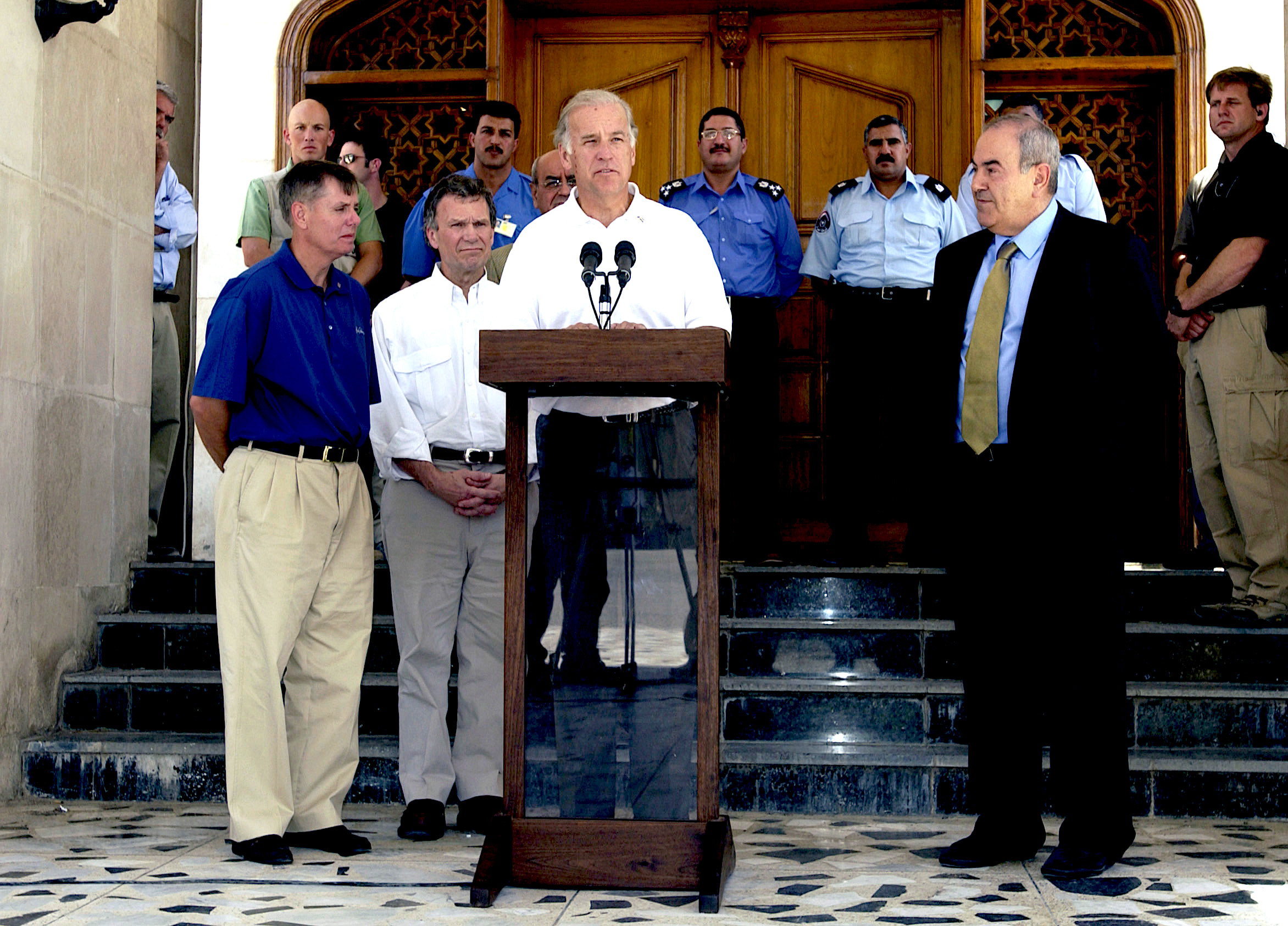
Senator Biden addressing the press inside the Green Zone in Baghdad after meeting with Iraq’s Interim Prime Minister lyad Allawi, on right, and fellow U.S. senators, from left, Lindsey Graham and Tom Daschle, June 19, 2004. (Office of U.S. Secretary of Defense, Wikimedia Commons, Public domain)
I used these documents to write an article that was published in the June 2000 issue of Arms Control Today which was subsequently distributed to all members of Congress. As I previously wrote in an article published in TruthDig, then-Senator Joe Biden dispatched a senior member of the minority staff of the Foreign Relations Committee to meet with me.
“This meeting,” I wrote, “was a singular disappointment. The staffer began by calling me a traitor for speaking out about Iraq and took umbrage when I backed up my claims with documents. ‘You are not supposed to have these materials,’ he said. ‘They are classified, and you are a traitor for publicizing the information they contain.’
“After reminding the staffer that he was walking a very dangerous line in calling a former officer of Marines a traitor, I pointed out that the information I cited was from my time as an inspector and was not classified in any way.
No U.S. intelligence sources or methods were compromised by my efforts. While U.S. policymakers may have been embarrassed by my revelations, this was only because truth did not comport with the policies they were pursuing.
I reminded the staffer of Biden’s stated desire to call on my ‘knowledge and expertise in the future,’ [note: this desire was expressed in a personal letter written by Biden to me in September 1998, following his much-publicized clash with me during my testimony before the U.S. Senate] noting that this meeting was supposed to be conducted in keeping with that intent in mind.
“Senator Biden will not be meeting with you,” the staffer declared. “You’re too controversial.”
I slid the Arms Control Today article across the table. “How are facts controversial?” I asked. “Point to one thing in this article that you believe to be false or misleading.”
The staffer agreed that the article was fact-based, even if he disagreed with its conclusion. “But this isn’t about facts. This is about politics, and Senator Biden will not go against the policies of the Clinton administration, even if those policies are failing.”
I couldn’t think of a more damning indictment of a public official.
Between my resignation from UNSCOM in 1998, and up through the U.S.-led invasion of Iraq in 2003, I wrote dozens of articles and opinion essays which were published in prestigious newspapers and magazines in the U.S. and around the world.
All of these touched upon the issue of whether Saddam Hussein’s Iraq continued to possess weapons of mass destruction.
In every article and essay I wrote, I debunked the lies being peddled by the Bush administration claiming Iraq was a threat worthy of war because of its continued pursuit and possession of proscribed weapons.
Every article was unassailable in terms of its factual predicate.
Because I had the receipts.
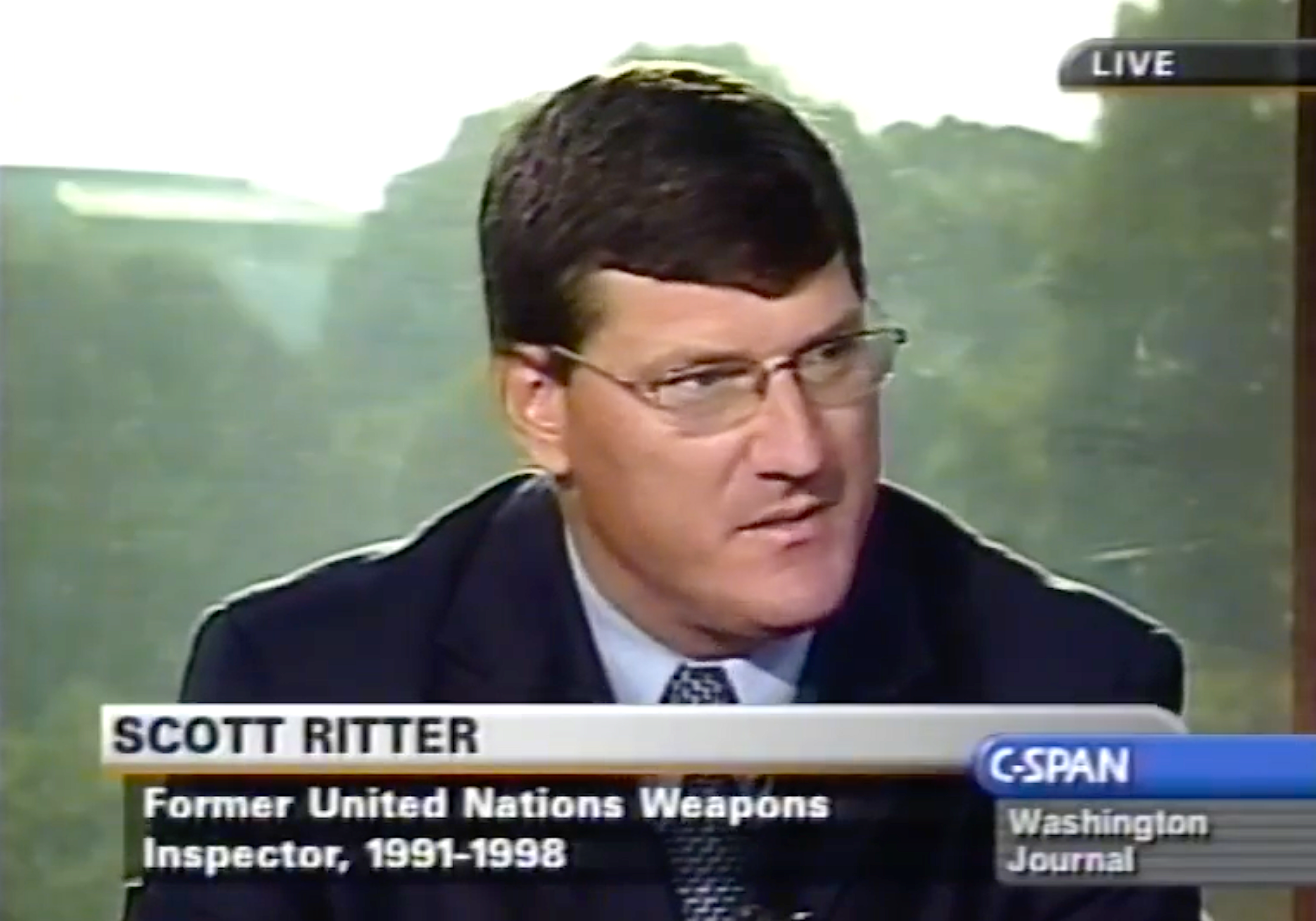
Scott Ritter on C-Span, August 2002. (C-Span screenshot)
One of the documents in my possession was the UNSCOM report on the debriefing of Saddam Hussein’s son-in-law in August 1995, following his defection from Iraq. In it, Hussein Kamal stated that under his orders all weapons of mass destruction had been destroyed by Iraq in the summer of 1991.
In August 2002, then-Vice President Dick Cheney told an audience of U.S. veterans that Saddam Hussein’s son-in-law had told the U.S. that Iraq had hidden its weapons of mass destruction from the U.N.
“But we now know that Saddam has resumed his efforts to acquire nuclear weapons,” Cheney said. “Among other sources, we’ve gotten this from the firsthand testimony from defectors — including Saddam’s own son-in-law, who was subsequently murdered at Saddam’s direction. Many of us are convinced that Saddam Hussein will acquire nuclear weapons fairly soon.”
I took the UNSCOM debriefing document to CNN, where they agreed to do a sit-down interview discussing its contents to contradict the false statement made by the vice president. But CNN was, at that time, a veritable tool of the U.S. government.
After the interview was in the can, CNN informed the Bush White House that it would be running the story. The Bush administration convinced CNN to kill the story in the interests of national security.
But I had the receipts.
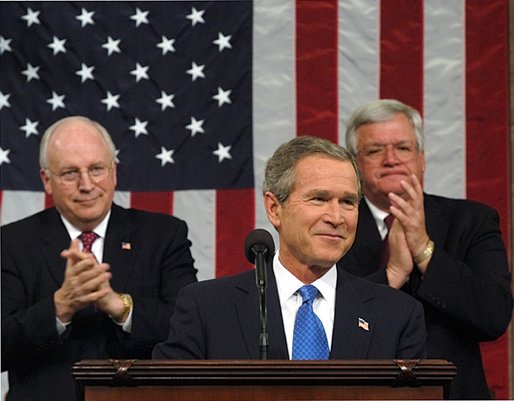
Jan. 28, 2003: President George W. Bush delivering the State of the Union Address with Cheney on left, House Speaker Dennis Hastert on right. (Wikimedia Commons, Public domain)
In early March 2003, on the eve of the U.S.-led invasion of Iraq, I made one last effort to get this information before the public. I reached out to John Barry, a reporter with Newsweek, and briefed him on the document’s existence. After he examined it and was assured of its authenticity, Barry wrote a piece which was published on March 3, 2003 — too late to stop the war.
But at least I had publicly put the lie to Dick Cheney’s claims.
Because I had the receipts.
I wrote a book that was published in 2005, Iraq Confidential: The Untold Story of the Intelligence Conspiracy to Undermine the U.N. and Overthrow Saddam Hussein. This book detailed the history of my work in UNSCOM disarming Iraq. The book is unassailable from a factual perspective, because in writing it I was able to draw upon by archive of documents.
My receipts.
I am in the process of finishing up a book provisionally titled The Scud Hunters, which details my experiences during the Gulf War and as an inspector in eliminating Iraq’s Scud missile force.
The book, if and when published, will be unassailable factually.
Because I have the receipts.
The F.B.I., in searching my home for personal electronics, visited my basement, where they encountered my file cabinet and its contents.
My archive.
The archive than enabled me to expose without fear of contradiction the lies told by the U.S. government and its agencies about Iraqi weapons of mass destruction.
The senior F.B.I. agent approached me with the bad news. “We found a bunch of classified documents in your basement,” he said.
“They aren’t classified,” I replied. I explained to him the history of the documents and referred him to the C.I.A. general council’s letter about classified documents and UNSCOM.
The agent left, only to return. “The assistant U.S. attorney says that we cannot leave these documents in your possession until this matter is investigated further.”
“They aren’t classified,” I said. “You have no right to take them.”
“Well, we are going to take them. If what you say checks out, we will return them back to you.”
The F.B.I. left with some two dozen boxes containing the totality of my UNSCOM archive.
My receipts.
The Only Independent Record

Justice Hugo Black in 1937. (Harris & Ewing, Wikimedia Commons, Public domain)
The only record of the truth about UNSCOM’s work in Iraq disarming Iraq that isn’t controlled by the U.S. government, which continues to promulgate lies about the reasons it invaded Iraq.
Simply put, the F.B.I. seized the literal truth.
In the receipt provided to me, the F.B.I. simply wrote down “documents.”
There is no way the F.B.I. will be able to wrap its head around these documents. I spotted one of the senior F.B.I. agents walking around with several Vu-Graph slides I had made in support of a briefing I had prepared for a meeting in the White House Situation Room with the Deputies Committee where I would detail an inspection concept of operations targeting sensitive sites in downtown Baghdad.
The White House had asked me to prepare a Power Point presentation, but that was beyond what I could do at UNSCOM. Instead, I took a bunch of maps, photos and diagrams to the local Kinko’s, where I slapped together a number of Vu-Graph’s.
“The Kinko’s brief!,” I said as she walked past.
The look in her eyes underscored that she had no clue what I was talking about.
And therein lies the rub.
While I am confident I will not get into any trouble about the archive (how can I? It is unclassified), I do not have any confidence that the F.B.I. will return the documents.
The U.S. government simply cannot allow an archive such as this to exist “in the wild.”
They will find some excuse.
This archive isn’t just my personal collection of documents.
This is an archive of truth.
Indisputable fact.
A source of knowledge and information unique in the world which has served a very useful purpose — to expose the lies of the government.
I am a journalist — my record clearly reflects this reality.
And as such, I am part of what the Founding Fathers called “a free press.”
In his concurring opinion of the landmark 1971 Supreme Court decision, The New York Times v. The United States, Justice Hugo Black noted the following:
“The press was to serve the governed, not the governors. The Government’s power to censor the press was abolished so that the press would remain forever free to censure the Government. The press was protected so that it could bare the secrets of the government and inform the people. Only a free and unrestrained press can effectively expose deception in government. And paramount among the responsibilities of a free press is the duty to prevent any part of the government from deceiving the people and sending them off to distant lands to die of foreign fevers and foreign shot and shell.”
As wielded by me, my UNSCOM archive literally fulfilled its duty of helping me “bare the secrets of the government and inform the people” to prevent the government from “deceiving the people and sending them off to distant lands to die of foreign fevers and foreign shot and shell.”
By seizing this archive, the F.B.I. literally engaged in an act of censorship.
In seizing my archive, the F.B.I. invoked the notion of “national security.” But, as Justice Black noted,
“The word ‘security’ is a broad, vague generality whose contours should not be invoked to abrogate the fundamental law embodied in the First Amendment. The guarding of military and diplomatic secrets at the expense of informed representative government provides no real security.”
There can be no doubt that my UNSCOM archive did more than any other source of documented information to apprise the American people about the lies of their government when it came to Iraqi weapons of mass destruction.
And now it is gone.
________________________________________
 Scott Ritter was a US Marine Corps intelligence officer for 12 years. As a chief weapons inspector for the UN Special Commission in Iraq, he was labeled a hero by some, a maverick by others and a spy by the Iraqi government. In charge of searching out weapons of mass destruction within Iraq, Ritter was on the front lines of the ongoing battle against arms proliferation. He has had an extensive and distinguished career in government service with assignments in the former Soviet Union and the Middle East. In 1991, Ritter joined the United Nations weapons inspections team, or UNSCOM. He participated in 34 inspection missions, 14 of them as chief inspector. Ritter resigned from UNSCOM in August 1998, citing U.S. interference in the inspections. He is the author of many books, including Scorpion King: America’s Suicidal Embrace of Nuclear Weapons from FDR to Trump; Iraq Confidential: The Untold Story of the Intelligence Conspiracy to Undermine the UN and Overthrow Saddam Hussein; Target Iran: The Truth about the White House’s Plans for Regime Change; and Waging Peace: The Art of War for the Antiwar Movement. Contributor author: Deal of the Century: How Iran Blocked the West’s Road to War, Clarity Press. He is a graduate of Franklin and Marshall College, with a B.A. in Soviet history.
Scott Ritter was a US Marine Corps intelligence officer for 12 years. As a chief weapons inspector for the UN Special Commission in Iraq, he was labeled a hero by some, a maverick by others and a spy by the Iraqi government. In charge of searching out weapons of mass destruction within Iraq, Ritter was on the front lines of the ongoing battle against arms proliferation. He has had an extensive and distinguished career in government service with assignments in the former Soviet Union and the Middle East. In 1991, Ritter joined the United Nations weapons inspections team, or UNSCOM. He participated in 34 inspection missions, 14 of them as chief inspector. Ritter resigned from UNSCOM in August 1998, citing U.S. interference in the inspections. He is the author of many books, including Scorpion King: America’s Suicidal Embrace of Nuclear Weapons from FDR to Trump; Iraq Confidential: The Untold Story of the Intelligence Conspiracy to Undermine the UN and Overthrow Saddam Hussein; Target Iran: The Truth about the White House’s Plans for Regime Change; and Waging Peace: The Art of War for the Antiwar Movement. Contributor author: Deal of the Century: How Iran Blocked the West’s Road to War, Clarity Press. He is a graduate of Franklin and Marshall College, with a B.A. in Soviet history.
Go to Original – consortiumnews.com
Tags: Anglo America, FBI, Journalism, Justice, Media, USA
DISCLAIMER: The statements, views and opinions expressed in pieces republished here are solely those of the authors and do not necessarily represent those of TMS. In accordance with title 17 U.S.C. section 107, this material is distributed without profit to those who have expressed a prior interest in receiving the included information for research and educational purposes. TMS has no affiliation whatsoever with the originator of this article nor is TMS endorsed or sponsored by the originator. “GO TO ORIGINAL” links are provided as a convenience to our readers and allow for verification of authenticity. However, as originating pages are often updated by their originating host sites, the versions posted may not match the versions our readers view when clicking the “GO TO ORIGINAL” links. This site contains copyrighted material the use of which has not always been specifically authorized by the copyright owner. We are making such material available in our efforts to advance understanding of environmental, political, human rights, economic, democracy, scientific, and social justice issues, etc. We believe this constitutes a ‘fair use’ of any such copyrighted material as provided for in section 107 of the US Copyright Law. In accordance with Title 17 U.S.C. Section 107, the material on this site is distributed without profit to those who have expressed a prior interest in receiving the included information for research and educational purposes. For more information go to: http://www.law.cornell.edu/uscode/17/107.shtml. If you wish to use copyrighted material from this site for purposes of your own that go beyond ‘fair use’, you must obtain permission from the copyright owner.
Join the discussion!
We welcome debate and dissent, but personal — ad hominem — attacks (on authors, other users or any individual), abuse and defamatory language will not be tolerated. Nor will we tolerate attempts to deliberately disrupt discussions. We aim to maintain an inviting space to focus on intelligent interactions and debates.